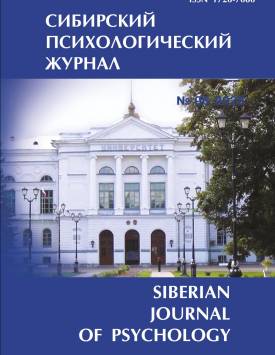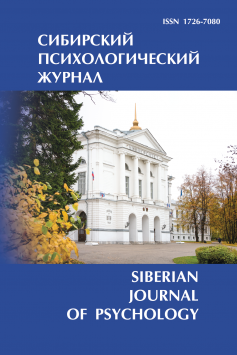Psychometric characteristics of Russian Language Version of the Bermond–Vorst Alexithymia Questionnaire (BVAQ)
Relevance and subject of the study. Measuring alexithymia levels is an important task due to the connection between its feature and a range of mental health and behavioral disorders. There is a lack of psychological instruments in the Russian language to investigate the various components of alexithymia. This study examines the psychometric properties of the Russian version of the Bermond-Vorst Alexithymia Questionnaire (BVAQ). Research methods and materials. The total sample consisted of 573 people ages 15-59, 137 males and 446 females. Exploratory and confirmatory analyses were conducted to verify the questionnaire's structure, consistency, and reliability. To test construct validity, we used the Toronto Alexithimia Scale (TAS-20) adapted by E. G. Starostina et al., the Satisfaction With Life Scale of E. Diener adapted by E. N. Osin & D. A. Leontiev, the Marlowe-Crowne Social Desirability Scale adapted by Yu. L. Khanin. Descriptive statistics of the inventory were calculated. Results. Analysis of the factor structure of the questionnaire revealed the greatest suitability of a bifactor model with a common grouping factor and associated subfactors. Models proposing the presence of cognitive and affective factors of alexithymia did not demonstrate adequate suitability levels. Exploratory factor analysis revealed that, while the overall structure of the questionnaire was preserved, the scale "emotionalizing" was divided into two subscales containing direct and inverse points, which may be due to cultural perceptual features. The questionnaire as a whole and its individual scales were characterized by sufficient internal consistency. A satisfactory retest reliability of the method was demonstrated. As part of the convergent validity verification of the inventory, the expected direct correlation between its indicator and the level of alexithymia on the TAS-20 was revealed, as well as a negative correlation with the satisfaction with life indicator. Divergent validity was supported by a lack of significant correlations with social desirability scale score. In general, it can be concluded that the psychometric properties of the proposed version of the BVAQ questionnaire were quite good, but the structure of the methodology requires further verification, including in the context of clarifying theoretical aspects of alexithymia.
Keywords
alexithymia,
cognitive and affective components of alexithymia,
Bermond-Vorst Alexithymia Questionnaire (BVAQ),
psychometric characteristics,
psychodiagnosticsAuthors
| Dorosheva Elena A. | Novosibirsk State University | elena.dorosheva@mail.ru |
| Burova Tatiana S. | Novosibirsk State University | burovatatiana02@gmail.com |
Всего: 2
References
Дорошева, Е. А., Бурова, Т. С. (2024). Обзор исследований двухфакторной модели алекситимии и ее психофизиологических оснований и валидность измерительного инструментария. Психология. Историко-критические обзоры и современные исследования, 13(2А), 33-43.
Искусных, А. Ю. (2015) Алекситимия. Причины и риски возникновения расстройства. Личность, семья и общество: вопросы педагогики и психологии, 52(6), 59-67.
Осин, Е. Н., Леонтьев, Д. А. (2020). Краткие русскоязычные шкалы диагностики субъективного благополучия: психометрические характеристики и сравнительный анализ. Мониторинг общественного мнения: экономические и социальные перемены, 1, 117-142. doi: 10.14515/monitoring.2020.1.06.
Старостина, Е. Г., Тэйлор, Г. Д., Квилти, Л. К., Бобров, А. Е., Мошняга, Е. Н., Пузырева, Н. В., ... Бэгби, Р. M. (2010). Торонтская шкала алекситимии (20 пунктов): валидизация русскоязычной версии на выборке терапевтических больных. Социальная и клиническая психология, 4, 32-38.
Ханин, Ю. Л. (1976). Шкала Марлоу-Кроуна для исследования мотивации одобрения. Л.: НИИ ФК.
Bagby, R. M., Parker, J. D. A., & Taylor, G. J. (1994). The twenty-item Toronto alexithymia scale-I. Item selection and cross-validation of the factor structure. Journal of Psychosomatic Research, dS(1), 23-32. doi: 10.1016/0022-3999(94)90005-1.
Bagby, R. M., Sanches, M., Carnovale, M., & Taylor G. J. (2021). An evaluation of alexithymia subtypes using latent profile analysis. Psychiatric Research, 299, 113840. doi: 10.1016/j.psychres.2021.113840.
Bermond, B., Clayton, K., Liberova, A., Luminet, O., Maruszewski, T., Bitti, P. E. R., ... Wicherts, J. (2007). A cognitive and an affective dimension of alexithymia in six languages and seven populations. Cognition and Emotion, 21(5), 1125-1136. doi: 10.1080/02699930601056989.
Blinka, L, Faltynkova, A, & Recka, K. (2024). Alexithymia in gaming addiction and engagement. Journal of Affective Disorders, 354(1), 104-109. doi: 10.1016/j.jad.2024.03.060.
Chaim, C. H., Almeida, T. M., de Vries Albertin, P., Santana G. L., Siu E. R., & Andrade L. H. (2024) The implication of alexithymia in personality disorders: a systematic review. BMC Psychiatry, 24, 647. doi: 10.1186/s12888-024-06083-6.
Daghigh, A. (2024). Beyond sleepless nights: Unraveling the complexity of alexithymia and suicide risk among university students. Brain and Behavior, 14(4), e3476. doi: 10.1002/brb3.3476.
Di Carlo, F., Vicinelli, M. C., Pettorruso, M., De Risio, L., Migliara, G., Baccolini, V., ... Martinotti, G. (2024). Connected minds in disconnected bodies: Exploring the role of interoceptive sensibility and alexithymia in problematic use of the internet.Comprehensive Psychiatry, 129, 152446. doi: 10.1016/j.comppsych.2023.152446.
Iskusnykh, A. Yu. (2015) Aleksitimiya. Prichiny i riski vozniknoveniya rasstroystva [Alexi-thymia. Causes and risks of the disorder]. Lichnost', sem'ya i obshchestvo: voprosy peda-gogiki ipsikhologii, 52(6), 59-67.
Jakobson, L. S., & Rigby, S. N. (2021). Alexithymia and Sensory Processing Sensitivity: Areas of Overlap and Links to Sensory Processing Styles. Frontiers in Psychology, 12, 583786. doi: 10.3389/fpsyg.2021.583786.
Kashimura, M., Ogawa, T., Vorst, H. C. M., & Bermond, B. (2011). Psychometric properties of the Bermond-Vorst Alexithymia Questionnaire in Japanese. Japanese Psychological Research, 53(3), 302-311. doi: 10.1111/j.1468-5884.2011.00472.x.
Luca, M., Luca, A., Patti, F., Algorta, G. P., & Eccles, F. J. R. (2024) Alexithymia and illness perceptions in persons with multiple sclerosis and their partners. Scientific Reports, 14, 25116. doi: 10.1038/s41598-024-76702-5.
Luminet, O., Nielson, K. A., & Ridout, N. (2021). Cognitive-emotional processing in alexithymia: an integrative review. Cognition and Emotion, 35(3), 449-487. doi: 10.1080/02699931.2021.1908231.
McQuarrie, A. M., Smith, S. D., & Jakobson, L. S. (2023) Alexithymia and sensory processing sensitivity account for unique variance in the prediction of emotional contagion and empathy. Frontiers in Psychology, 14, 1072783. doi: 10.3389/fpsyg.2023.1072783.
Orsolini, L. (2020). Unable to Describe My Feelings and Emotions Without an Addiction: The Interdependency Between Alexithymia and Addictions. Frontiers in Psychiatry, 11, 543346. doi: 10.3389/fpsyt.2020.543346.
Preece, D. A., & Gross, J. J. (2023). Conceptualizing alexithymia. Personality and Individual Differences, 215, 112375. doi: 10.1016/j.paid.2023.112375.
Preece, D. A., Mehta, A., Petrova, K., Sikka, P., Bjureberg, J., Becerra, R., & Gross, J. J. (2023). Alexithymia and emotion regulation. Journal of Affective Disorders, 324, 232238. doi: 10.1016/j.jad.2022.12.065.
Preece, D. A., Mehta, A., Becerra, R., Chen, W., Allan, A., Robinson, K., ... Gross, J. J. (2022). Why is alexithymia a risk factor for affective disorder symptoms? The role of emotion regulation. Journal of Affective Disorders, 296, 337-341. doi: 10.1016/ j.jad.2021.09.085.
Riadh, O., Naoufel, O., Rejeb, M. R. B., & Le Gall, D. (2019). Neuro-cognitive correlates of alexithymia in patients with circumscribed prefrontal cortex damage. Neuropsychologia, 135, 107228. doi: 10.1016/j.neuropsychologia.2019.107228.
Sifneos, P. E. (1973). The prevalence of 'alexithymic' characteristics in psychosomatic patients. Psychotherapy andPsychosomatics, 2-6 (22), 255-262. doi: 10.1159/000286529.
Taylor G. J., Ryan D., & Bagby R. M. (1985). Toward the development of a new self-report alexithymia scale. Psychotherapy and Psychosomatics, 4(44), 191-199. doi: 10.1159/ 000287912.
Torunsky, N. T., Knauz, S., Vilares, I., Marcoulides, K. M., & Koutstaal, W. (2023) What is the relationship between alexithymia and experiential avoidance? A latent analysis using three alexithymia questionnaires. Personality and Individual Differences, 214, 112308. doi: 10.1016/j.paid.2023.112308.
Vorst, H. C. M., & Bermond, B. (2001) Validity and reliability of the Bermond-Vorst Alexithymia Questionnaire. Personality and Individual Differences, 30(3), 413-434. doi: 0.1016/S0191-8869(00)0003.
Wang, Z., Wang, T., Goerlich, K. S., Pitliya, R. J., Bermond, B., Aleman, A., ... Luo, Y. (2021). Psychometric Properties of the Chinese Bermond-Vorst Alexithymia Questionnaire: An Exploratory Structural Equation Modeling Study. Journal of Pacific Rim Psychology, 15, 1834490921991429. doi: 10.1177/1834490921991429.

